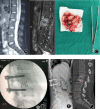Development and Application of Oblique Lumbar Interbody Fusion
- PMID: 32174024
- PMCID: PMC7967883
- DOI: 10.1111/os.12625
Development and Application of Oblique Lumbar Interbody Fusion
Abstract
The present study reviewed the relevant recent literature regarding the development and application of oblique lumbar interbody fusion (OLIF), with a particular focus on its application and associated complications. The study evaluated the rationality of this technique and demonstrated the direction of future research by collecting data on previous operative outcomes and complications. A literature search was performed in Pubmed and Web of Science, including the following keywords and abbreviations: anterior lumbar interbody fusion (ALIF), lateral lumbar interbody fusion (LLIF), direct lateral interbody fusion (DLIF), extreme lateral interbody fusion (XLIF), oblique lateral interbody fusion (OLIF), adjacent segment disease (ASD), and adult degenerative scoliosis (ADS). A search of literature published from January 2005 to January 2019 was conducted and all studies evaluating development and application of OLIF were included in the review. According to the literature, the indications for OLIF are various. OLIF has excellent orthopaedic effects in degenerative scoliosis patients and the incidence of bony fusion is higher than for other approaches. It also provides a better choice for revision surgery. It has various advantages in many aspects, but the complications cannot be ignored. As a new minimally invasive technique, the advantages of OLIF are obvious, but further evaluation is needed to compare its operation-related data with that of traditional open surgery. In addition, more prospective studies are required to compare minimally invasive and open spinal surgery to confirm its specific efficacy, risk, advantages, learning curve, and ultimate clinical efficacy.
Keywords: Complications of OLIF; Development and application; Oblique Lumbar Interbody Fusion (OLIF).
© 2020 The Authors. Orthopaedic Surgery published by Chinese Orthopaedic Association and John Wiley & Sons Australia, Ltd.
Figures





References
-
- Jagersberg M, Schneider K, Schaller C, Richter M. ALIF versus TLIF for post‐discectomy syndrome. J Neurol Surg, 2014, 75: 329–355. - PubMed
-
- Capener N. Spondylolisthesis. Br J Surg, 1932, 19: 374–386.
-
- Lindley EM, Mcbeth ZL, Henry SE, et al. Retrograde ejaculation after anterior lumbar spine surgery. Spine (Phila pa 1976), 2012, 37: 1785–1789. - PubMed
-
- Pimenta L. Lateral endoscopic transpsoas retroperitoneal approach for lumbar spine surgery. Presented at: VIII Brazilian Spine Society Meeting; 2001; Belo Horizonte, Minas Gerais, Brazil.
-
- Ozgur BM, HE A, Pimenta L, Taylor WR. Extreme lateral interbody fusion (XLIF): a novel surgical technique for anterior lumbar interbody fusion. Spine J, 2006, 6: 435–443. - PubMed
Publication types
MeSH terms
LinkOut - more resources
Full Text Sources
Research Materials

